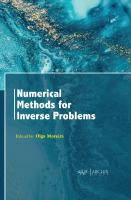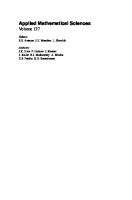Forward and Inverse Problems for Hyperbolic, Elliptic and Mixed Type Equations (Inverse & ill-posed problems series) 9067643793, 9789067643795
Inverse problems are an important and rapidly developing direction in mathematics,mathematical physics, differential equ
149 30 1MB
English Pages 244 [242] Year 2003
Table of contents :
Introduction
Chapter 1. Inverse problems for semibounded string with the directional derivative condition given in the end
1.1. Formulation of the direct problem
1.2. The form of solution of the direct problem convenient for solving the inverse problems
1.3. The inverse problem with the data u (0, .)and .u/.z|z=q
1.4. The inverse problem for semibounded string which has no analog in the case . = 0
Chapter 2. Inverse problems for the elliptic equation in the half-plane
2.1. Formulation of the direct problem
2.2. The form of solution of the direct problem applied for solution of the inverse problems
2.3. The setting and solution of the inverse problems
Chapter 3. Inverse problems of scattering plane waves from inhomogeneous transition layers (half-space)
3.1. The direct problem
3.2. Determination of properties of inhomogeneous layer by the forms of incident and reflected waves given for a single angle .0
3.3. The method of recovery of the density and the speed in the inhomogeneous layer as the functions of the depth given the set of plane waves reflected from the layer at various angles
3.4. The algorithm of numerical solution of the inverse problem 3.3 (determination of v(z) and .(z) by the forms .1{.,.0) of incident and reflected waves for three angles .0)
3.5. Derivation of the speed v(z) and the density .(z) in the numerical experiments
Chapter 4. Inverse problems for finite string with the condition of directional derivative in one end
4.1. Formulation of the direct problem
4.2. Solution of the direct problem
4.3. The inverse problem with the data in the free end of the string
4.4. The inverse problem with the data set in the boundary z = 0
4.5. Inverse problems for the string with the fixed end z = H
Chapter 5. Inverse problems for the elliptic equation in the strip
5.1. Setting of the direct problem
5.2. Solution of the direct problem
5.3. The inverse problem with the data in the boundary z = H
5.4. The inverse problem with the data in the boundary z = 0
5.5. Problems with the condition u(H, .)=0
Chapter 6. Inverse problems of scattering the plane waves from inhomogeneous layers with a free or fixed boundary
6.1. The direct problem
6.2. Determination of properties of the inhomogeneous layer given the data for a single angle of incidence
6.3. Determination of the depth of inhomogeneous layer, the density .(z) and the speed v(z) in this layer if the form of incident wave .0(., .0) is known is known
6.4. Determination of the depth of inhomogeneous layer, the density .(z), the speed v(z) in the layer and the form of incident wave
Chapter 7. Direct and inverse problems for the equations of mixed type
7.1. Formulation and the uniqueness theorem for the direct problem
7.2. The representation of solution of the direct problem 7.1. The case of K(h + 0) . 0, K(h - 0) . 0
7.3. The case of LavrentievBitsadze equation. The formulas for solution of the direct problem 7.1
7.4. Inverse problems. The case K(h + 0) . 0, K(h - 0) . 0
7.5. The general case
7.6. The other problems
7.7. The physical content
Chapter 8. Inverse problems connected with determination of arbitrary set of point sources
8.1. Direct problem and its solution
8.2. Some auxiliary geometrical definitions
8.3. The auxiliary results for the case 1 connected with the T-systems
8.4. Preliminary remarks on solutions of the inverse problems
8.5. The static inverse problem with the data on the strait line
8.6. The nonstationary inverse problem with the data given in the straight line for the case 1
8.7. The inverse static and nonstationary problems
8.8. On zeros of the field u(x, y, z) of form (8.1.13)
8.9. The zeros of the function u(x,y,z,t) of form (8.1.4) or (8.1.5) in the plane z = 0
8.10. Solution of the nonstationary inverse problem 8.1 in the case 2 for E = E1, E2, E3, E5, E6
8.11. Stationary inverse problem
8.12. Possible applications
Bibliography
Introduction
Chapter 1. Inverse problems for semibounded string with the directional derivative condition given in the end
1.1. Formulation of the direct problem
1.2. The form of solution of the direct problem convenient for solving the inverse problems
1.3. The inverse problem with the data u (0, .)and .u/.z|z=q
1.4. The inverse problem for semibounded string which has no analog in the case . = 0
Chapter 2. Inverse problems for the elliptic equation in the half-plane
2.1. Formulation of the direct problem
2.2. The form of solution of the direct problem applied for solution of the inverse problems
2.3. The setting and solution of the inverse problems
Chapter 3. Inverse problems of scattering plane waves from inhomogeneous transition layers (half-space)
3.1. The direct problem
3.2. Determination of properties of inhomogeneous layer by the forms of incident and reflected waves given for a single angle .0
3.3. The method of recovery of the density and the speed in the inhomogeneous layer as the functions of the depth given the set of plane waves reflected from the layer at various angles
3.4. The algorithm of numerical solution of the inverse problem 3.3 (determination of v(z) and .(z) by the forms .1{.,.0) of incident and reflected waves for three angles .0)
3.5. Derivation of the speed v(z) and the density .(z) in the numerical experiments
Chapter 4. Inverse problems for finite string with the condition of directional derivative in one end
4.1. Formulation of the direct problem
4.2. Solution of the direct problem
4.3. The inverse problem with the data in the free end of the string
4.4. The inverse problem with the data set in the boundary z = 0
4.5. Inverse problems for the string with the fixed end z = H
Chapter 5. Inverse problems for the elliptic equation in the strip
5.1. Setting of the direct problem
5.2. Solution of the direct problem
5.3. The inverse problem with the data in the boundary z = H
5.4. The inverse problem with the data in the boundary z = 0
5.5. Problems with the condition u(H, .)=0
Chapter 6. Inverse problems of scattering the plane waves from inhomogeneous layers with a free or fixed boundary
6.1. The direct problem
6.2. Determination of properties of the inhomogeneous layer given the data for a single angle of incidence
6.3. Determination of the depth of inhomogeneous layer, the density .(z) and the speed v(z) in this layer if the form of incident wave .0(., .0) is known is known
6.4. Determination of the depth of inhomogeneous layer, the density .(z), the speed v(z) in the layer and the form of incident wave
Chapter 7. Direct and inverse problems for the equations of mixed type
7.1. Formulation and the uniqueness theorem for the direct problem
7.2. The representation of solution of the direct problem 7.1. The case of K(h + 0) . 0, K(h - 0) . 0
7.3. The case of LavrentievBitsadze equation. The formulas for solution of the direct problem 7.1
7.4. Inverse problems. The case K(h + 0) . 0, K(h - 0) . 0
7.5. The general case
7.6. The other problems
7.7. The physical content
Chapter 8. Inverse problems connected with determination of arbitrary set of point sources
8.1. Direct problem and its solution
8.2. Some auxiliary geometrical definitions
8.3. The auxiliary results for the case 1 connected with the T-systems
8.4. Preliminary remarks on solutions of the inverse problems
8.5. The static inverse problem with the data on the strait line
8.6. The nonstationary inverse problem with the data given in the straight line for the case 1
8.7. The inverse static and nonstationary problems
8.8. On zeros of the field u(x, y, z) of form (8.1.13)
8.9. The zeros of the function u(x,y,z,t) of form (8.1.4) or (8.1.5) in the plane z = 0
8.10. Solution of the nonstationary inverse problem 8.1 in the case 2 for E = E1, E2, E3, E5, E6
8.11. Stationary inverse problem
8.12. Possible applications
Bibliography

- Author / Uploaded
- A. G. Megrabov
- Alexander G. Megrabov




![Introduction to Inverse Problems for Differential Equations [2nd ed. 2021]
3030794261, 9783030794262](https://ebin.pub/img/200x200/introduction-to-inverse-problems-for-differential-equations-2nd-ed-2021-3030794261-9783030794262.jpg)



![Differential equations: inverse and direct problems [1 ed.]
9781420011135, 9781584886044, 1584886048](https://ebin.pub/img/200x200/differential-equations-inverse-and-direct-problems-1nbsped-9781420011135-9781584886044-1584886048.jpg)
